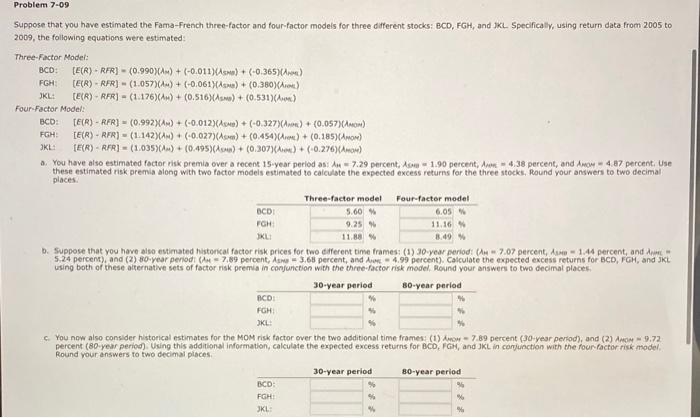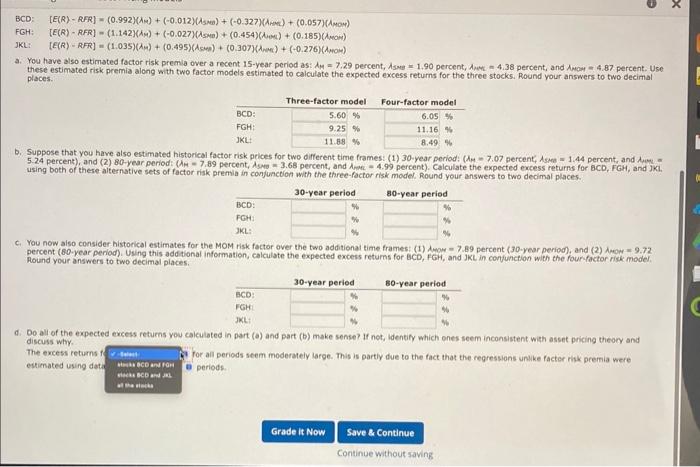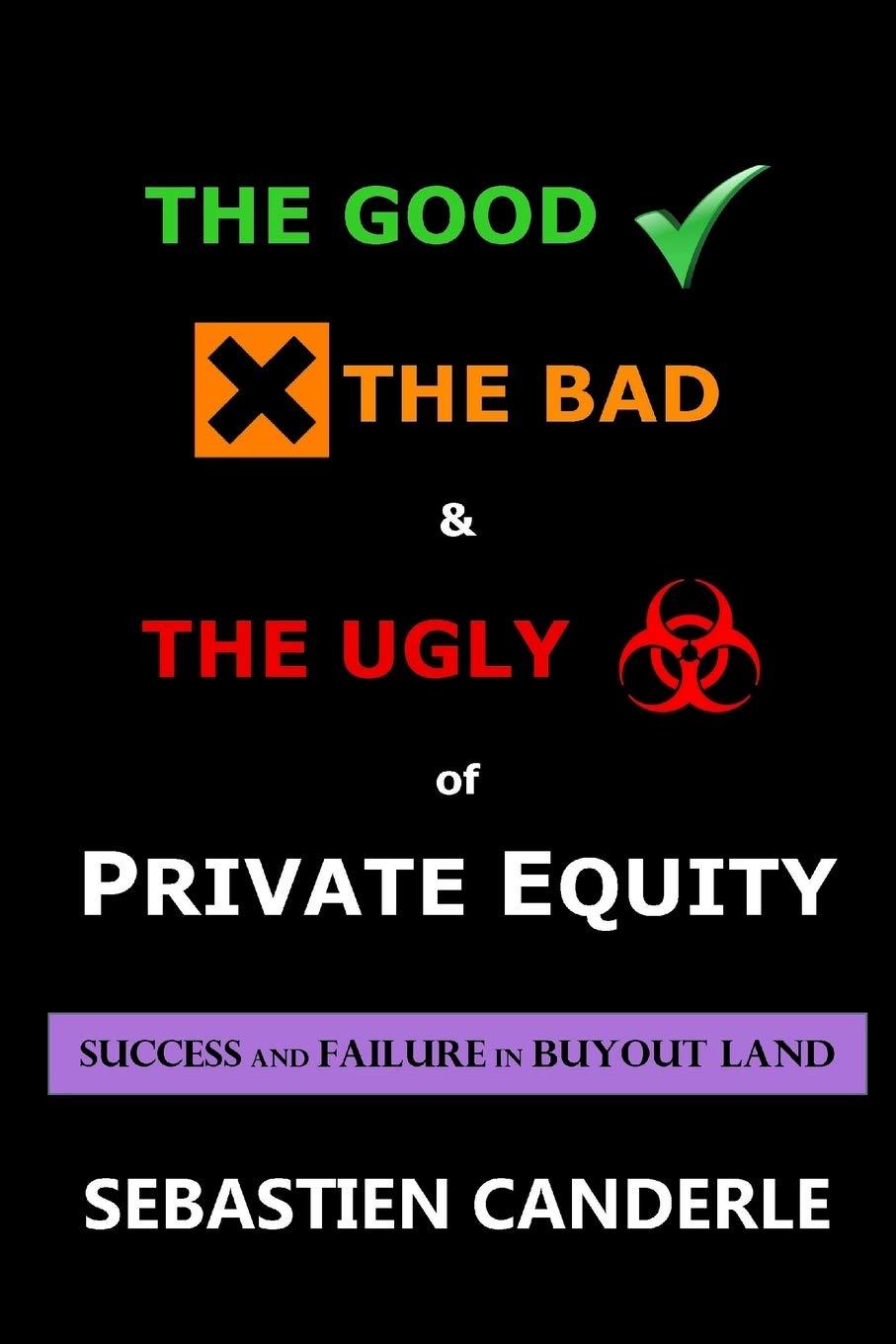Answered step by step
Verified Expert Solution
Question
1 Approved Answer
Please answer B C and D. Thanks Suppose that you have estimated the Fama-French three-factor and four-factor modeis for three different stocks: BCD, FGH, and
Please answer B C and D. Thanks 


Suppose that you have estimated the Fama-French three-factor and four-factor modeis for three different stocks: BCD, FGH, and JKL. Specifically, using return data from 2005 to 2009 , the following equations were estimated: Three-Factor Modei: BCD:[E(R)RFR]=(0.990)(4)+(0.011)(1smos)+(0.365)(nos)FGH:[E(R)RFR]=(1.057)(4)+(0.061)(Aswe)+(0.360)(Aioc)JKL:[E(R)AFR]=(1.176)(A)+(0.516)(swo)+(0.531)(ow) Four-Factor Models a. You have also estimated foctor risk premia over a recent 15 -year period as: Au =7.29 percent, Acei =1.90 percent, Aion =4.38 percent, and Amou =4.87 percent, Use these estimated risk premia along with two foctor modeis estimated to calculate the expected excess returns for the three stocks, found your answers to two decimal places. b. Suppose that you have also estimated historical foctor risk prices for two ciferent time frames: (1) 30-year neriod: (Ay =7.07 percent, Aiai =1.44 percent, and Auaic = using both of these aiternative sets of factor risk premia in conjunction with the three-factor risk mode, Round your answers to two decimat places. BCD:[E(R)AFR]=(0.992)(Ain)+(0.012)(AsNe)+(0.327)(ANM)+(0.057)(MMo4)FGH:[E(R)RFR]=(1.142)(9)+(0.027)(sNo)+(0.454)(mot)+(0.185)(mon)JKL:[E(R)RFR]=(1.035)(A19)+(0.495)(scen)+(0.307)(nuc)+(0.276)(mol) a. You have also estimated factor risk premia over a recent 15 -year period as: Ay=7.29 percent, A swe =1,90 percent, Aum. m4.38 percent, and Awoy =4.87 percent. Use these estimated risk premia along with two factor models estimated to calculate the expected excess retums for the three stocks. Round your answers to two decimal places. b. Suppose that you have also estimated historical factor risk prices for two different time frames: (1) 30 year period: (Am in 7.07 percent, Asmen = 1.44 percent, and Aim. 5.24 percent), and (2) 80-year period: ( AH=7.89 percent, son =3.68 percent, and A ywa =4.99 percent). Calculate the expected excess returns for BCC, FGH, and JKt. using both of these alternative sets of factor risk premia in conjunction with the three-factor risk model. Round your answers to two decimal piaces. c. You now aiso consider historical estimates for the MOM risk foctor over the two additional time frames: (1) dwow = 7.69 percent (30-year period), and (2) Amow = 9.72 percent (60-year peniod). Using this additional information, calculate the expected excess retums for BCD, FGH, and 3KL in contunction with che four-foctor rick modef. Round your answers to two decimal places. d. Do all of the expected excess returns you calculated in part (a) and part (b) make sense? If not, ldentify which ones seem inconsistent with asset pricing theory and discuss why. The excess returns ff estimated using data for all periods seem moderately large. This is oartly due to the fact that the regressions unike factor risk premia were periods. Chapter 07: Assignment-Asset Pricing Models BCD:[E(R)RFR]=(0.992)(H)+(0.012)(smen)+(0.327)(Nas)+(0.057)(nom)FGH:[E(R)RFR]=(1.142)()+(0.027)(swm)+(0.454)(tow)+(0.185)(McM)JKL[E(R)RFR]=(1.035)(N)+(0.495)(sua)+(0.307)(Nac)+(0.276)(mow) a. You have also estimated factor risk premia over a recent 15 -year period as: or =7.29 percent, som =1.90 percent, we =4.38 percent, and mok =4.87 percent. Use these cstimated risk premia along with two factor models estimated to calculate the expected excess returns for the three stocks. Round your answers to two decimal places. b. Suppose that you have also estimated historical factor risk prices for two different time frames: (1) 30 -year period: (Ay =7.07 percent; sime =1.44 percent, and Ahed = 5.24 percent), and (2) 80-year period: (A. =7.89 percent, Aswe =3.68 percent, and dime =4.99 percent). Calculate the expected excess returns for BCD, FGH, and 3KC. using both of these alternative sets of factor risk premia in conjunction with the the dactactor risk model. Round your answers to two decimal places. c. You now also consider historical estimates for the MoM risk factor over the two additional time frames: (1) Amo4 =7.69 percent (30-year period), and (2) Awow = 9.72 percent (60-year period). Using this additional information, calkulate the expected excess returns for BCD, FGH, and JKL in conjunction with the founfactor risk model. Round your answers to two decimal places. d. Do all of the expected excess returns you calculated in part (a) and part (b) make sense? If not, ldentify which ones seem inconsistent with asset peicing theory and discuss why. The excess returns for for all periods seem moderately large. This is partly due to the fact that the regressions unlike factor risk premia were estimated using data from mu periods. Continue without saving Suppose that you have estimated the Fama-French three-factor and four-factor modeis for three different stocks: BCD, FGH, and JKL. Specifically, using return data from 2005 to 2009 , the following equations were estimated: Three-Factor Modei: BCD:[E(R)RFR]=(0.990)(4)+(0.011)(1smos)+(0.365)(nos)FGH:[E(R)RFR]=(1.057)(4)+(0.061)(Aswe)+(0.360)(Aioc)JKL:[E(R)AFR]=(1.176)(A)+(0.516)(swo)+(0.531)(ow) Four-Factor Models a. You have also estimated foctor risk premia over a recent 15 -year period as: Au =7.29 percent, Acei =1.90 percent, Aion =4.38 percent, and Amou =4.87 percent, Use these estimated risk premia along with two foctor modeis estimated to calculate the expected excess returns for the three stocks, found your answers to two decimal places. b. Suppose that you have also estimated historical foctor risk prices for two ciferent time frames: (1) 30-year neriod: (Ay =7.07 percent, Aiai =1.44 percent, and Auaic = using both of these aiternative sets of factor risk premia in conjunction with the three-factor risk mode, Round your answers to two decimat places. BCD:[E(R)AFR]=(0.992)(Ain)+(0.012)(AsNe)+(0.327)(ANM)+(0.057)(MMo4)FGH:[E(R)RFR]=(1.142)(9)+(0.027)(sNo)+(0.454)(mot)+(0.185)(mon)JKL:[E(R)RFR]=(1.035)(A19)+(0.495)(scen)+(0.307)(nuc)+(0.276)(mol) a. You have also estimated factor risk premia over a recent 15 -year period as: Ay=7.29 percent, A swe =1,90 percent, Aum. m4.38 percent, and Awoy =4.87 percent. Use these estimated risk premia along with two factor models estimated to calculate the expected excess retums for the three stocks. Round your answers to two decimal places. b. Suppose that you have also estimated historical factor risk prices for two different time frames: (1) 30 year period: (Am in 7.07 percent, Asmen = 1.44 percent, and Aim. 5.24 percent), and (2) 80-year period: ( AH=7.89 percent, son =3.68 percent, and A ywa =4.99 percent). Calculate the expected excess returns for BCC, FGH, and JKt. using both of these alternative sets of factor risk premia in conjunction with the three-factor risk model. Round your answers to two decimal piaces. c. You now aiso consider historical estimates for the MOM risk foctor over the two additional time frames: (1) dwow = 7.69 percent (30-year period), and (2) Amow = 9.72 percent (60-year peniod). Using this additional information, calculate the expected excess retums for BCD, FGH, and 3KL in contunction with che four-foctor rick modef. Round your answers to two decimal places. d. Do all of the expected excess returns you calculated in part (a) and part (b) make sense? If not, ldentify which ones seem inconsistent with asset pricing theory and discuss why. The excess returns ff estimated using data for all periods seem moderately large. This is oartly due to the fact that the regressions unike factor risk premia were periods. Chapter 07: Assignment-Asset Pricing Models BCD:[E(R)RFR]=(0.992)(H)+(0.012)(smen)+(0.327)(Nas)+(0.057)(nom)FGH:[E(R)RFR]=(1.142)()+(0.027)(swm)+(0.454)(tow)+(0.185)(McM)JKL[E(R)RFR]=(1.035)(N)+(0.495)(sua)+(0.307)(Nac)+(0.276)(mow) a. You have also estimated factor risk premia over a recent 15 -year period as: or =7.29 percent, som =1.90 percent, we =4.38 percent, and mok =4.87 percent. Use these cstimated risk premia along with two factor models estimated to calculate the expected excess returns for the three stocks. Round your answers to two decimal places. b. Suppose that you have also estimated historical factor risk prices for two different time frames: (1) 30 -year period: (Ay =7.07 percent; sime =1.44 percent, and Ahed = 5.24 percent), and (2) 80-year period: (A. =7.89 percent, Aswe =3.68 percent, and dime =4.99 percent). Calculate the expected excess returns for BCD, FGH, and 3KC. using both of these alternative sets of factor risk premia in conjunction with the the dactactor risk model. Round your answers to two decimal places. c. You now also consider historical estimates for the MoM risk factor over the two additional time frames: (1) Amo4 =7.69 percent (30-year period), and (2) Awow = 9.72 percent (60-year period). Using this additional information, calkulate the expected excess returns for BCD, FGH, and JKL in conjunction with the founfactor risk model. Round your answers to two decimal places. d. Do all of the expected excess returns you calculated in part (a) and part (b) make sense? If not, ldentify which ones seem inconsistent with asset peicing theory and discuss why. The excess returns for for all periods seem moderately large. This is partly due to the fact that the regressions unlike factor risk premia were estimated using data from mu periods. Continue without saving 


Step by Step Solution
There are 3 Steps involved in it
Step: 1

Get Instant Access to Expert-Tailored Solutions
See step-by-step solutions with expert insights and AI powered tools for academic success
Step: 2

Step: 3

Ace Your Homework with AI
Get the answers you need in no time with our AI-driven, step-by-step assistance
Get Started


